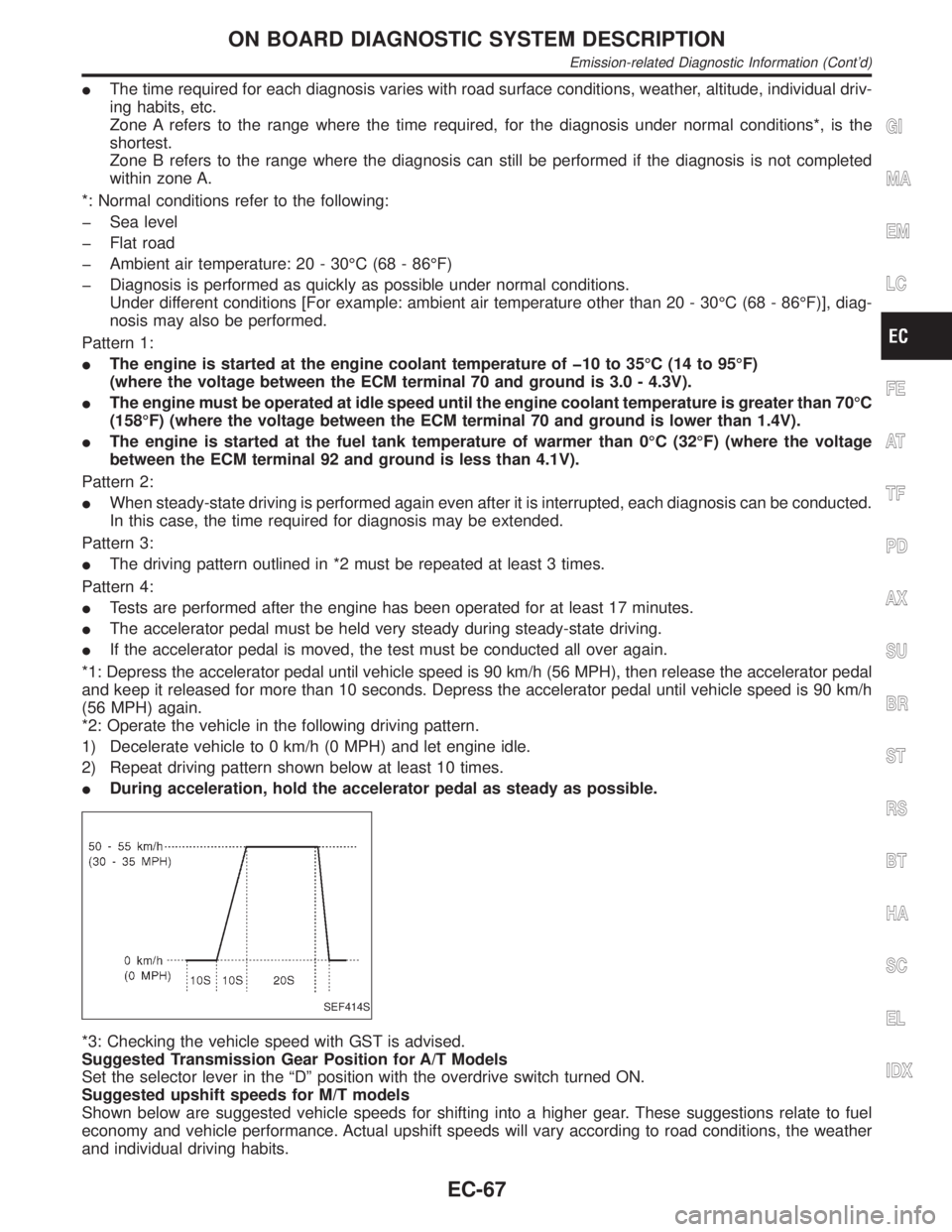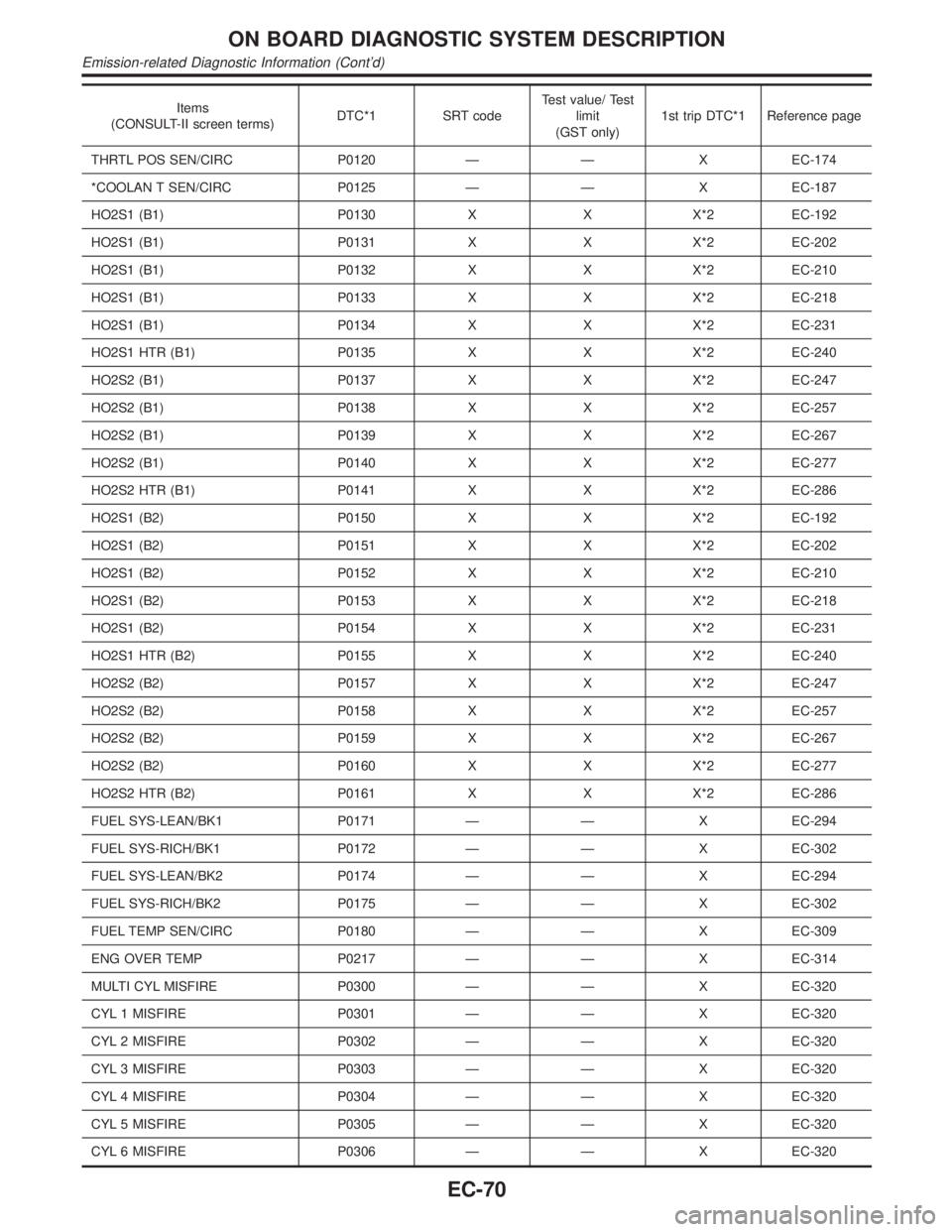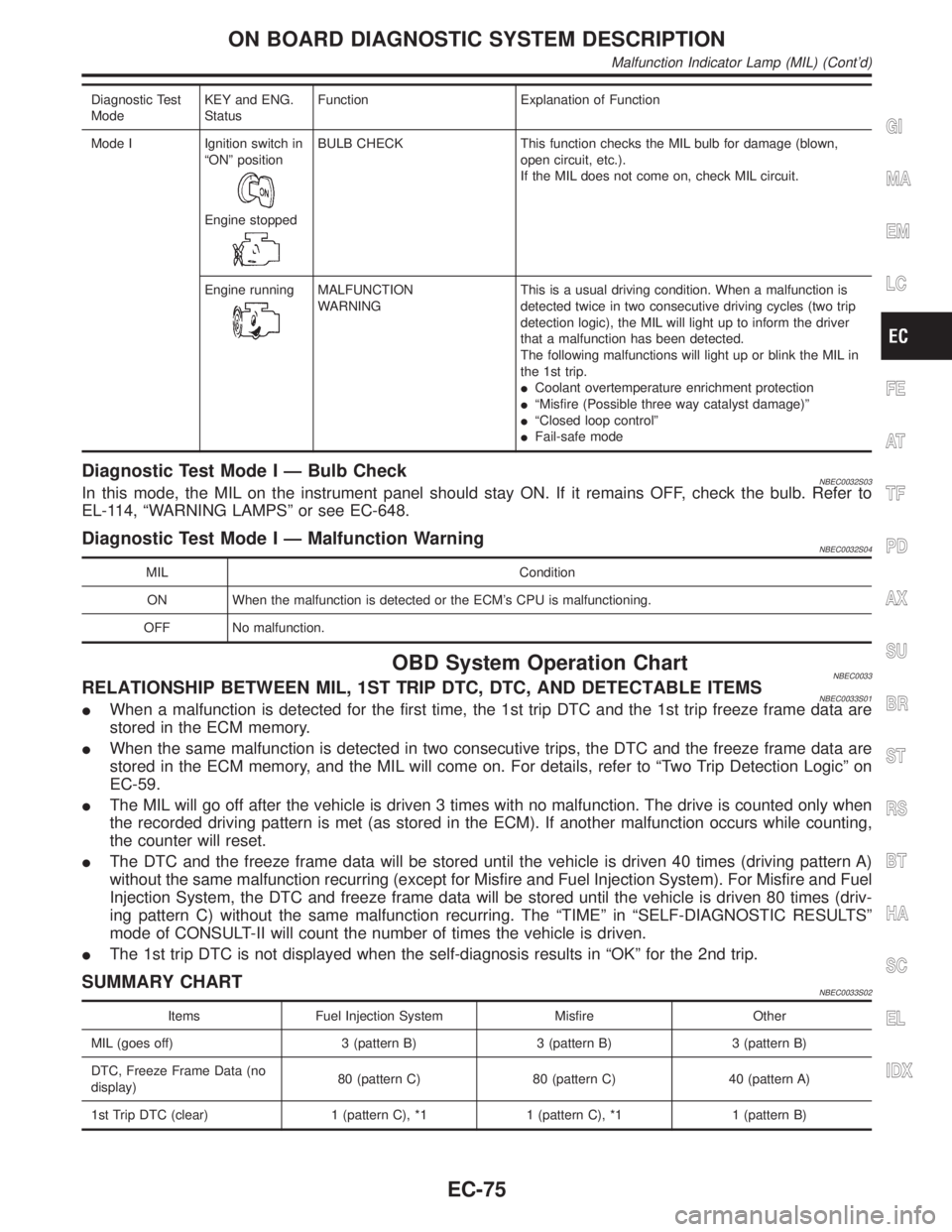INFINITI QX4 2001 Factory Service Manual
Manufacturer: INFINITI, Model Year: 2001, Model line: QX4, Model: INFINITI QX4 2001Pages: 2395, PDF Size: 43.2 MB
Page 601 of 2395

Driving PatternNBEC0031S0303
SEF947Y
ON BOARD DIAGNOSTIC SYSTEM DESCRIPTION
Emission-related Diagnostic Information (Cont'd)
EC-66
Page 602 of 2395

IThe time required for each diagnosis varies with road surface conditions, weather, altitude, individual driv-
ing habits, etc.
Zone A refers to the range where the time required, for the diagnosis under normal conditions*, is the
shortest.
Zone B refers to the range where the diagnosis can still be performed if the diagnosis is not completed
within zone A.
*: Normal conditions refer to the following:
þ Sea level
þ Flat road
þ Ambient air temperature: 20 - 30ÉC (68 - 86ÉF)
þ Diagnosis is performed as quickly as possible under normal conditions.
Under different conditions [For example: ambient air temperature other than 20 - 30ÉC (68 - 86ÉF)], diag-
nosis may also be performed.
Pattern 1:
IThe engine is started at the engine coolant temperature of þ10 to 35ÉC (14 to 95ÉF)
(where the voltage between the ECM terminal 70 and ground is 3.0 - 4.3V).
IThe engine must be operated at idle speed until the engine coolant temperature is greater than 70ÉC
(158ÉF) (where the voltage between the ECM terminal 70 and ground is lower than 1.4V).
IThe engine is started at the fuel tank temperature of warmer than 0ÉC (32ÉF) (where the voltage
between the ECM terminal 92 and ground is less than 4.1V).
Pattern 2:
IWhen steady-state driving is performed again even after it is interrupted, each diagnosis can be conducted.
In this case, the time required for diagnosis may be extended.
Pattern 3:
IThe driving pattern outlined in *2 must be repeated at least 3 times.
Pattern 4:
ITests are performed after the engine has been operated for at least 17 minutes.
IThe accelerator pedal must be held very steady during steady-state driving.
IIf the accelerator pedal is moved, the test must be conducted all over again.
*1: Depress the accelerator pedal until vehicle speed is 90 km/h (56 MPH), then release the accelerator pedal
and keep it released for more than 10 seconds. Depress the accelerator pedal until vehicle speed is 90 km/h
(56 MPH) again.
*2: Operate the vehicle in the following driving pattern.
1) Decelerate vehicle to 0 km/h (0 MPH) and let engine idle.
2) Repeat driving pattern shown below at least 10 times.
IDuring acceleration, hold the accelerator pedal as steady as possible.
SEF414S
*3: Checking the vehicle speed with GST is advised.
Suggested Transmission Gear Position for A/T Models
Set the selector lever in the ªDº position with the overdrive switch turned ON.
Suggested upshift speeds for M/T models
Shown below are suggested vehicle speeds for shifting into a higher gear. These suggestions relate to fuel
economy and vehicle performance. Actual upshift speeds will vary according to road conditions, the weather
and individual driving habits.
GI
MA
EM
LC
FE
AT
TF
PD
AX
SU
BR
ST
RS
BT
HA
SC
EL
IDX
ON BOARD DIAGNOSTIC SYSTEM DESCRIPTION
Emission-related Diagnostic Information (Cont'd)
EC-67
Page 603 of 2395
![INFINITI QX4 2001 Factory Service Manual For normal acceleration in low altitude areas
[less than 1,219 m (4,000 ft)]:For quick acceleration in low altitude
areas and high altitude areas
[over 1,219 m (4,000 ft)]:
Gear changeACCEL shift poin INFINITI QX4 2001 Factory Service Manual For normal acceleration in low altitude areas
[less than 1,219 m (4,000 ft)]:For quick acceleration in low altitude
areas and high altitude areas
[over 1,219 m (4,000 ft)]:
Gear changeACCEL shift poin](/img/42/57027/w960_57027-602.png)
For normal acceleration in low altitude areas
[less than 1,219 m (4,000 ft)]:For quick acceleration in low altitude
areas and high altitude areas
[over 1,219 m (4,000 ft)]:
Gear changeACCEL shift point
km/h (MPH)CRUISE shift point
km/h (MPH)km/h (MPH)
1st to 2nd 21 (13) 21 (13) 24 (15)
2nd to 3rd 37 (23) 26 (16) 40 (25)
3rd to 4th 53 (33) 44 (27) 64 (40)
4th to 5th 63 (39) 58 (36) 72 (45)
Suggested Maximum Speed in Each Gear
Downshift to a lower gear if the engine is not running smoothly, or if you need to accelerate.
Do not exceed the maximum suggested speed (shown below) in any gear. For level road driving, use the
highest gear suggested for that speed. Always observe posted speed limits and drive according to the road
conditions to ensure safe operation. Do not over-rev the engine when shifting to a lower gear as it may cause
engine damage or loss of vehicle control.
Gear km/h (MPH)
1st 50 (30)
2nd 89 (55)
3rd 128 (80)
4th Ð
5th Ð
TEST VALUE AND TEST LIMIT (GST ONLY Ð NOT APPLICABLE TO CONSULT-II)NBEC0031S04The following is the information specified in Mode 6 of SAE J1979.
The test value is a parameter used to determine whether a system/circuit diagnostic test is ªOKº or ªNGº while
being monitored by the ECM during self-diagnosis. The test limit is a reference value which is specified as the
maximum or minimum value and is compared with the test value being monitored.
Items for which these data (test value and test limit) are displayed are the same as SRT code items (30 test
items).
These data (test value and test limit) are specified by Test ID (TID) and Component ID (CID) and can be dis-
played on the GST screen.
X: Applicable Ð: Not applicable
SRT item Self-diagnostic test itemTest value (GST display)
Test limit Application
TID CID
C ATA LY S TThree way catalyst function
(Right bank)01H 01H Max. X
Three way catalyst function
(Left bank)03H 02H Max. X
EVAP SYSTEMEVAP control system
(Small leak)05H 03H Max. X
EVAP control system purge flow
monitoring06H 83H Min. X
ON BOARD DIAGNOSTIC SYSTEM DESCRIPTION
Emission-related Diagnostic Information (Cont'd)
EC-68
Page 604 of 2395

SRT item Self-diagnostic test itemTest value (GST display)
Test limit Application
TID CID
O2 SENSORHeated oxygen sensor 1 (front)
(bank 1)09H 04H Max. X
0AH 84H Min. X
0BH 04H Max. X
0CH 04H Max. X
0DH 04H Max. X
Heated oxygen sensor 1 (front)
(bank 2)11H 05H Max. X
12H 85H Min. X
13H 05H Max. X
14H 05H Max. X
15H 05H Max. X
Heated oxygen sensor 2 (rear)
(bank 1)19H 86H Min. X
1AH 86H Min. X
1BH 06H Max. X
1CH 06H Max. X
Heated oxygen sensor 2 (rear)
(bank 2)21H 87H Min. X
22H 87H Min. X
23H 07H Max. X
24H 07H Max. X
O2 SENSOR HEATERHeated oxygen sensor 1 (front) heater
(bank 1)29H 08H Max. X
2AH 88H Min. X
Heated oxygen sensor 1 (front) heater
(bank 2)2BH 09H Max. X
2CH 89H Min. X
Heated oxygen sensor 2 (rear) heater
(bank 1)2DH 0AH Max. X
2EH 8AH Min. X
Heated oxygen sensor 2 (rear) heater
(bank 2)2FH 0BH Max. X
30H 8BH Min. X
EMISSION-RELATED DIAGNOSTIC INFORMATION ITEMSNBEC0031S05X: Applicable Ð: Not applicable
Items
(CONSULT-II screen terms)DTC*1 SRT codeTest value/ Test
limit
(GST only)1st trip DTC*1 Reference page
NO DTC IS DETECTED.
FURTHER TESTING
MAY BE REQUIRED.P0000ÐÐÐÐ
MAF SEN/CIRCUIT P0100 Ð Ð X EC-150
ABSL PRES SEN/CIRC P0105 Ð Ð X EC-158
AIR TEMP SEN/CIRC P0110 Ð Ð X EC-164
COOLANT T SEN/CIRC P0115 Ð Ð X EC-169
GI
MA
EM
LC
FE
AT
TF
PD
AX
SU
BR
ST
RS
BT
HA
SC
EL
IDX
ON BOARD DIAGNOSTIC SYSTEM DESCRIPTION
Emission-related Diagnostic Information (Cont'd)
EC-69
Page 605 of 2395

Items
(CONSULT-II screen terms)DTC*1 SRT codeTest value/ Test
limit
(GST only)1st trip DTC*1 Reference page
THRTL POS SEN/CIRC P0120 Ð Ð X EC-174
*COOLAN T SEN/CIRC P0125 Ð Ð X EC-187
HO2S1 (B1) P0130 X X X*2 EC-192
HO2S1 (B1) P0131 X X X*2 EC-202
HO2S1 (B1) P0132 X X X*2 EC-210
HO2S1 (B1) P0133 X X X*2 EC-218
HO2S1 (B1) P0134 X X X*2 EC-231
HO2S1 HTR (B1) P0135 X X X*2 EC-240
HO2S2 (B1) P0137 X X X*2 EC-247
HO2S2 (B1) P0138 X X X*2 EC-257
HO2S2 (B1) P0139 X X X*2 EC-267
HO2S2 (B1) P0140 X X X*2 EC-277
HO2S2 HTR (B1) P0141 X X X*2 EC-286
HO2S1 (B2) P0150 X X X*2 EC-192
HO2S1 (B2) P0151 X X X*2 EC-202
HO2S1 (B2) P0152 X X X*2 EC-210
HO2S1 (B2) P0153 X X X*2 EC-218
HO2S1 (B2) P0154 X X X*2 EC-231
HO2S1 HTR (B2) P0155 X X X*2 EC-240
HO2S2 (B2) P0157 X X X*2 EC-247
HO2S2 (B2) P0158 X X X*2 EC-257
HO2S2 (B2) P0159 X X X*2 EC-267
HO2S2 (B2) P0160 X X X*2 EC-277
HO2S2 HTR (B2) P0161 X X X*2 EC-286
FUEL SYS-LEAN/BK1 P0171 Ð Ð X EC-294
FUEL SYS-RICH/BK1 P0172 Ð Ð X EC-302
FUEL SYS-LEAN/BK2 P0174 Ð Ð X EC-294
FUEL SYS-RICH/BK2 P0175 Ð Ð X EC-302
FUEL TEMP SEN/CIRC P0180 Ð Ð X EC-309
ENG OVER TEMP P0217 Ð Ð X EC-314
MULTI CYL MISFIRE P0300 Ð Ð X EC-320
CYL 1 MISFIRE P0301 Ð Ð X EC-320
CYL 2 MISFIRE P0302 Ð Ð X EC-320
CYL 3 MISFIRE P0303 Ð Ð X EC-320
CYL 4 MISFIRE P0304 Ð Ð X EC-320
CYL 5 MISFIRE P0305 Ð Ð X EC-320
CYL 6 MISFIRE P0306 Ð Ð X EC-320
ON BOARD DIAGNOSTIC SYSTEM DESCRIPTION
Emission-related Diagnostic Information (Cont'd)
EC-70
Page 606 of 2395

Items
(CONSULT-II screen terms)DTC*1 SRT codeTest value/ Test
limit
(GST only)1st trip DTC*1 Reference page
KNOCK SEN/CIRC-B1 P0325 Ð Ð Ð EC-328
CPS/CIRCUIT (POS) P0335 Ð Ð X EC-334
CAM PS/CIRC (PHS) P0340 Ð Ð X EC-342
TW CATALYST SYS-B1 P0420 X X X*2 EC-347
TW CATALYST SYS-B2 P0430 X X X*2 EC-347
EVAP SMALL LEAK P0440 X X X*2 EC-352
PURG VOLUME CONT/V P0443 Ð Ð X EC-367
VENT CONTROL VALVE P0446 Ð Ð X EC-374
EVAP SYS PRES SEN P0450 Ð Ð X EC-381
EVAP GROSS LEAK P0455 X X X*2 EC-394
FUEL LV SE (SLOSH) P0460 Ð Ð X EC-407
FUEL LEVEL SENSOR P0461 Ð Ð X EC-411
FUEL LEVEL SEN/CIRC P0464 Ð Ð X EC-413
VEH SPEED SEN/CIRC P0500 Ð Ð X EC-417
IACV/AAC VLV/CIRC P0505 Ð Ð X EC-422
CLOSED TP SW/CIRC P0510 Ð Ð X EC-431
A/T COMM LINE P0600 Ð Ð Ð EC-440
ECM P0605 Ð Ð X EC-444
PNP SW/CIRC P0705 Ð Ð X AT-111
ATF TEMP SEN/CIRC P0710 Ð Ð X AT-116
VEH SPD SEN/CIR AT P0720 Ð Ð X AT-124
ENGINE SPEED SIG P0725 Ð Ð X AT-130
A/T 1ST GR FNCTN P0731 Ð Ð X AT-136
A/T 2ND GR FNCTN P0732 Ð Ð X AT-143
A/T 3RD GR FNCTN P0733 Ð Ð X AT-151
A/T 4TH GR FNCTN P0734 Ð Ð X AT-157
TCC SOLENOID/CIRC P0740 Ð Ð X AT-165
A/T TCC S/V FNCTN P0744 Ð Ð X AT-170
L/PRESS SOL/CIRC P0745 Ð Ð X AT-174
SFT SOL A/CIRC P0750 Ð Ð X AT-180
SFT SOL B/CIRC P0755 Ð Ð X AT-189
INT/V TIM CONT-B1 P1110 Ð Ð X EC-446
INT/V TIM V/CIR-B1 P1111 Ð Ð XEC-451
SWIRL CONT SOL/V P1130 Ð Ð X EC-458
INT/V TIM CONT-B2 P1135 Ð Ð X EC-446
INT/V TIM V/CIR-B2 P1136 Ð Ð X EC-451
INTK TIM S/CIRC-B1 P1140 Ð Ð X EC-482
GI
MA
EM
LC
FE
AT
TF
PD
AX
SU
BR
ST
RS
BT
HA
SC
EL
IDX
ON BOARD DIAGNOSTIC SYSTEM DESCRIPTION
Emission-related Diagnostic Information (Cont'd)
EC-71
Page 607 of 2395

Items
(CONSULT-II screen terms)DTC*1 SRT codeTest value/ Test
limit
(GST only)1st trip DTC*1 Reference page
INTK TIM S/CIRC-B2 P1145 Ð Ð X EC-482
CLOSED LOOP-B1 P1148 Ð Ð X EC-491
SWL CON VC SW/CIRC P1165 Ð Ð X EC-493
CLOSED LOOP-B2 P1168 Ð Ð X EC-491
ENG OVER TEMP P1217 Ð Ð X LC-24
IGN SIGNAL-PRIMARY P1320 Ð Ð X EC-499
CPS/CIRCUIT (REF) P1335 Ð Ð X EC-510
CPS/CIRC (POS) COG P1336 Ð Ð X EC-517
EVAP VERY SMALL LEAK P1441 X X X*2 EC-526
PURG VOLUME CONT/V P1444 Ð Ð X EC-541
VENT CONTROL VALVE P1446 Ð Ð X EC-553
EVAP PURG FLOW/MON P1447 X X X*2 EC-561
VENT CONTROL VALVE P1448 Ð Ð X EC-573
FUEL LEVEL SEN/CIRC P1464 Ð Ð X EC-582
VC/V BYPASS/V P1490 Ð Ð X EC-585
VC CUT/V BYPASS/V P1491 Ð Ð X EC-591
A/T DIAG COMM LINE P1605 Ð Ð X EC-603
TP SEN/CIRC A/T P1705 Ð Ð X AT-218
P-N POS SW/CIRCUIT P1706 Ð Ð X EC-604
O/R CLTCH SOL/CIRC P1760 Ð Ð X AT-223
*1: 1st trip DTC No. is the same as DTC No.
*2: These are not displayed with GST.
NOTE:
Regarding R50 models, ª-B1º and ªBK1º indicate right bank and ª-B2º and ªBK2º indicate left bank.
HOW TO ERASE EMISSION-RELATED DIAGNOSTIC INFORMATIONNBEC0031S06How to Erase DTC (With CONSULT-II)NBEC0031S0601NOTE:
If the DTC is not for A/T related items (see EC-8), skip steps 2 through 4.
1. If the ignition switch stays ªONº after repair work, be sure to turn ignition switch ªOFFº once. Wait at least
10 seconds and then turn it ªONº (engine stopped) again.
2. Turn CONSULT-II ªONº and touch ªA/Tº.
3. Touch ªSELF-DIAG RESULTSº.
4. Touch ªERASEº. [The DTC in the TCM (Transmission control module) will be erased.] Then touch ªBACKº
twice.
5. Touch ªENGINEº.
6. Touch ªSELF-DIAG RESULTSº.
7. Touch ªERASEº. (The DTC in the ECM will be erased.)
IIf DTCs are displayed for both ECM and TCM (Transmission control module), they need to be erased
individually from the ECM and TCM (Transmission control module).
ON BOARD DIAGNOSTIC SYSTEM DESCRIPTION
Emission-related Diagnostic Information (Cont'd)
EC-72
Page 608 of 2395

SEF823YA
The emission related diagnostic information in the ECM can be erased by selecting ªERASEº in the ªSELF-
DIAG RESULTSº mode with CONSULT-II.
How to Erase DTC (With GST)NBEC0031S0602NOTE:
If the DTC is not for A/T related items (see EC-8), skip step 2.
1. If the ignition switch stays ªONº after repair work, be sure to turn ignition switch ªOFFº once. Wait at least
10 seconds and then turn it ªONº (engine stopped) again.
2. Perform ªSELF-DIAGNOSTIC PROCEDURE (Without CONSULT-II)º in AT section titled ªTROUBLE
DIAGNOSISº, ªSelf-diagnosisº. (The engine warm-up step can be skipped when performing the diagnosis
only to erase the DTC.)
3. Select Mode 4 with GST (Generic Scan Tool).
The emission related diagnostic information in the ECM can be erased by selecting Mode 4 with GST.
IIf the battery is disconnected, the emission-related diagnostic information will be lost after approx.
24 hours.
IThe following data are cleared when the ECM memory is erased.
1) Diagnostic trouble codes
2) 1st trip diagnostic trouble codes
3) Freeze frame data
4) 1st trip freeze frame data
5) System readiness test (SRT) codes
6) Test values
7) Others
GI
MA
EM
LC
FE
AT
TF
PD
AX
SU
BR
ST
RS
BT
HA
SC
EL
IDX
ON BOARD DIAGNOSTIC SYSTEM DESCRIPTION
Emission-related Diagnostic Information (Cont'd)
EC-73
Page 609 of 2395

Actual work procedures are explained using a DTC as an example. Be careful so that not only the DTC, but
all of the data listed above, are cleared from the ECM memory during work procedures.
IVIS (INFINITI VEHICLE IMMOBILIZER SYSTEM Ð NATS)NBEC0031S08
SEF515Y
IIf the security indicator lights up with the ignition switch in the ªONº position or ªNATS MALFUNC-
TIONº is displayed on ªSELF-DIAG RESULTSº screen, perform self-diagnostic results mode with
CONSULT-II using NATS program card. Refer to ªIVIS (Infiniti Vehicle Immobilizer System Ð NATS)º
in EL section.
IConfirm no self-diagnostic results of IVIS (NATS) is displayed before touching ªERASEº in ªSELF-
DIAG RESULTSº mode with CONSULT-II.
IWhen replacing ECM, initialization of IVIS (NATS) system and registration of all IVIS (NATS) igni-
tion key IDs must be carried out with CONSULT-II using NATS program card.
Therefore, be sure to receive all keys from vehicle owner. Regarding the procedures of IVIS (NATS)
initialization and IVIS (NATS) ignition key ID registration, refer to CONSULT-II operation manual,
IVIS/NVIS.
Malfunction Indicator Lamp (MIL)
DESCRIPTIONNBEC0032
SEF217U
The MIL is located on the instrument panel.
1. The MIL will light up when the ignition switch is turned ON without the engine running. This is a bulb check.
IIf the MIL does not light up, refer to EL-114, ªWARNING LAMPSº or see EC-648.
2. When the engine is started, the MIL should go off.
If the MIL remains on, the on board diagnostic system has detected an engine system malfunction.
On Board Diagnostic System FunctionNBEC0032S01The on board diagnostic system has the following two functions.
ON BOARD DIAGNOSTIC SYSTEM DESCRIPTION
Emission-related Diagnostic Information (Cont'd)
EC-74
Page 610 of 2395

Diagnostic Test
ModeKEY and ENG.
StatusFunction Explanation of Function
Mode I Ignition switch in
ªONº position
Engine stopped
BULB CHECK This function checks the MIL bulb for damage (blown,
open circuit, etc.).
If the MIL does not come on, check MIL circuit.
Engine running
MALFUNCTION
WARNINGThis is a usual driving condition. When a malfunction is
detected twice in two consecutive driving cycles (two trip
detection logic), the MIL will light up to inform the driver
that a malfunction has been detected.
The following malfunctions will light up or blink the MIL in
the 1st trip.
ICoolant overtemperature enrichment protection
IªMisfire (Possible three way catalyst damage)º
IªClosed loop controlº
IFail-safe mode
Diagnostic Test Mode I Ð Bulb CheckNBEC0032S03In this mode, the MIL on the instrument panel should stay ON. If it remains OFF, check the bulb. Refer to
EL-114, ªWARNING LAMPSº or see EC-648.
Diagnostic Test Mode I Ð Malfunction WarningNBEC0032S04
MIL Condition
ON When the malfunction is detected or the ECM's CPU is malfunctioning.
OFF No malfunction.
OBD System Operation ChartNBEC0033RELATIONSHIP BETWEEN MIL, 1ST TRIP DTC, DTC, AND DETECTABLE ITEMSNBEC0033S01IWhen a malfunction is detected for the first time, the 1st trip DTC and the 1st trip freeze frame data are
stored in the ECM memory.
IWhen the same malfunction is detected in two consecutive trips, the DTC and the freeze frame data are
stored in the ECM memory, and the MIL will come on. For details, refer to ªTwo Trip Detection Logicº on
EC-59.
IThe MIL will go off after the vehicle is driven 3 times with no malfunction. The drive is counted only when
the recorded driving pattern is met (as stored in the ECM). If another malfunction occurs while counting,
the counter will reset.
IThe DTC and the freeze frame data will be stored until the vehicle is driven 40 times (driving pattern A)
without the same malfunction recurring (except for Misfire and Fuel Injection System). For Misfire and Fuel
Injection System, the DTC and freeze frame data will be stored until the vehicle is driven 80 times (driv-
ing pattern C) without the same malfunction recurring. The ªTIMEº in ªSELF-DIAGNOSTIC RESULTSº
mode of CONSULT-II will count the number of times the vehicle is driven.
IThe 1st trip DTC is not displayed when the self-diagnosis results in ªOKº for the 2nd trip.
SUMMARY CHARTNBEC0033S02
Items Fuel Injection System Misfire Other
MIL (goes off) 3 (pattern B) 3 (pattern B) 3 (pattern B)
DTC, Freeze Frame Data (no
display)80 (pattern C) 80 (pattern C) 40 (pattern A)
1st Trip DTC (clear) 1 (pattern C), *1 1 (pattern C), *1 1 (pattern B)
GI
MA
EM
LC
FE
AT
TF
PD
AX
SU
BR
ST
RS
BT
HA
SC
EL
IDX
ON BOARD DIAGNOSTIC SYSTEM DESCRIPTION
Malfunction Indicator Lamp (MIL) (Cont'd)
EC-75